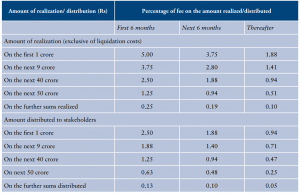
The Union government has proposed a number of changes to the Insolvency and Bankruptcy Code as it looks to make the law more efficient and transparent. It also seeks to expand the scope of the legal framework and make the resolutions faster. It is seeking responses from stakeholders and general public which can be submitted by February 7. Of the several changes proposed are streamlining of the insolvency resolution process and the recasting of the liquidation process, says a release from the ministry of corporate affairs.
The proposal seeks to grant sweeping powers to the adjudicating authority. It also calls for mandatory admission of insolvency applications filed by financial creditors (FCs), and proposes a specialised framework for real estate, providing major relief to allottees. It also looks at expanding the scope of pre-packaged insolvency schemes beyond MSMEs.
READ | Pharma industry: R&D efforts to boost India’s global standing
The draft also proposes a state-of-the-art electronic platform which will be used to create a case management system. The same will also be deployed for automating processes to file applications, delivery of notices, and interaction of insolvency professionals with stakeholders. Digital India has been a major focus point of the Narendra Modi government which is promoting e-governance in a big way. The e-platform will allow regulators to exercise better oversight over their respective domains of functioning through consolidated information available on the platform.

Besides, the government has also proposed to amend Section 10 of the IBC to remove the right of the corporate debtor to propose an insolvency professional. It has now recommended that in such instances, the insolvency professional should be appointed by the adjudicating authority on the recommendation of the insolvency and bankruptcy board of India (IBBI).

While IBC is hailed as a critical reform in the Indian banking sector, the recovery to lenders through the mechanism is still a matter of concern. Banks have been undertaking huge haircuts in many cases. According to data released by the IBBI, more distressed companies have been liquidated under the bankruptcy code compared with those rescued as of March-end. The numbers are telling. Between December 2016 and March 2022, 47% of corporate insolvency processes went into liquidation. On the other hand, merely 14% ended in a resolution plan.
What is Insolvency and Bankruptcy Code
Introduced in 2016 to fast track the resolution of the non-performing assets (NPAs) of banks, the Insolvency and Bankruptcy Code is a one-stop solution for resolving insolvencies. Before the introduction of IBC, resolution of NPAs was a tedious process that did not offer an economically viable arrangement. The premise of the code is that the interests of small investors must be protected and the process of doing business must be made less cumbersome. The IBC has 255 sections and 11 Schedules.
The IBC process has changed the debtor-creditor relationship in the country. A number of major cases have been resolved in two years, while some others are in advanced stages of resolution. Companies have to complete the entire insolvency exercise within 180 days under IBC. The deadline may be extended if the creditors do not raise objections. If debt resolution doesn’t happen, the company goes for liquidation.
Some of the famous cases resolved under IBC are Essar Steel, Videocon Industries, Dewan Housing Finance Ltd (DHFL), and Bhushan Steel. Essar Steel not only became a landmark IBC case but the bidding race fetched the lenders 85% in returns on the steelmaker’s debt of Rs 49,000 crore. The IBC is the nation’s first comprehensive law to address the insolvency of corporate persons and individuals. This is not the first time that the government is updating the code. It has made a slew of amendments previously as well with the introduction of new frameworks for various entities in the last few years.

